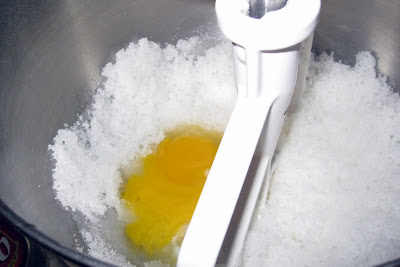Last night, for the first time ever, I baked a cake in a silicone bundt pan. GASP! Yup, I faced one of my biggest baking fears, bit the bullet, and used a flimsy, flexible, hard-to-keep-lint-out-because-it-sticks-to-the-pan red Wilton silicone pan.
Here's how it started.
I went to a friend's to bake a cake and even brought my conventional metal, fail-proof pan with me. It's heavy-duty, and I've used it enough times to know it does my cakes justice.
But when my friend presented me with her silicone alternative, all feelings of safeness and ease were chucked out the window and a sinking feeling overwhelmed me. Should I use the pan I brought that I know works? Or should I try this wobbly thingamabobber some people swear by but I have yet to trust?
While never having tried it myself, I'm not unfamiliar with silicone bakeware. Between testimonials from friends and plenty of reading on the Internet and in cookbooks, I have valid concerns about the adequacy of said bakeware and what it does to the integrity of my cakes.
Here are just a few things I've heard about silicone bakeware that have freaked me out (NOTE: These are rumors and should not be taken as fact):
- It's actually more difficult to remove the cake from the pan and you can't use a knife to cut the cake away because you'll tear the material
- Since it's a thinner material than metal, it burns the cake and you have to watch the cooking time carefully
- It doesn't produce crusts or edges on your baked goods
- It's difficult to wash and dry
- Lint sticks to it
- It's a challenge to take the cake out of the oven because it's not sturdy. As you're lifting the pan out, you might tear the cake as it wobbles around because it hasn't cooled and set yet.
I do have one confession to make.
As with plenty of scary things in life, baby steps are useful and make it easier to handle the challenge you're facing. So instead of diving right in and embracing the silicone pan for all its alleged goodness, I took the supposedly unnecessary measure of greasing and flouring the pan. Please don't mock me!
The Result
My cake baked evenly in the pan, so that's relief #1. It also didn't stick to the pan one bit: relief #2 (though if you recall my confession, I may have tampered with the test a little). But on the downside, when I inserted a toothpick in the center and it needed about 10 more minutes to bake, it already looked done on the outside. I think it ended up overcooking the outside a little, just as I feared. The solution to that is to cover the cake with foil partway through baking so the outside doesn't burn while you give the inside a chance to finish baking. So while that downside is annoying, it's not a deal-breaker.
I think the biggest problem I have with the pan is its flimsiness. As suspected, it wobbled when I took it out of the oven, even as I took extreme care to keep it still. The super hot cake is in a very fragile state immediately out of the oven, and its structure continues to set during the cooling. I almost broke the cake in half as I lifted it out of the oven because the silicone pan it was in was not supporting its still-setting delicate state.
If I use this pan again, I will absolutely place the pan on a cookie sheet and bake it like that. Not only does using a cookie sheet make it easy to lift the cake out of the oven, but the double thickness of having two pans will help prevent burning on the bottom of the cake. But the key here is if. If I will use this pan again. The fact that every time I use it it's going to give me butterflies is not good! But then again, last night's cake worked out, so maybe I'm panicking over nothing? At least now I can cross "using silicone bakeware" off the list of things to do before I die. Phew!
Have you ever used silicone bakeware? Are you a fan of it? Any disaster stories? Do tell!





































